ENGIN3201 Project: Timber Design for a Theatre Restaurant Renovation
VerifiedAdded on 2022/08/26
|15
|1072
|17
Project
AI Summary
This project presents the design of a theatre restaurant using timber as the primary construction material, transforming an existing building into a functional and aesthetically pleasing space. The design incorporates an architectural layout with a reception bar, restaurant seating, a performance stage, a fully furnished kitchen, and changing rooms. A mezzanine lounge with a bar is included, accessible via a wooden staircase. The structural design focuses on the use of wooden columns, trusses (flat and scissors), and flooring. Calculations and references are provided to support the structural integrity and compliance with relevant standards, such as AS1170.1. The design emphasizes the exposure of timber elements and the integration of services, highlighting the material's versatility and aesthetic appeal. The project includes considerations for lighting, ventilation, and space optimization to create an inviting environment for patrons.

Running Head: ENGIN3201-Structural Design 1
ENGIN3201-Structural Design
Student’s Name
Institutional Affiliation
ENGIN3201-Structural Design
Student’s Name
Institutional Affiliation
Paraphrase This Document
Need a fresh take? Get an instant paraphrase of this document with our AI Paraphraser
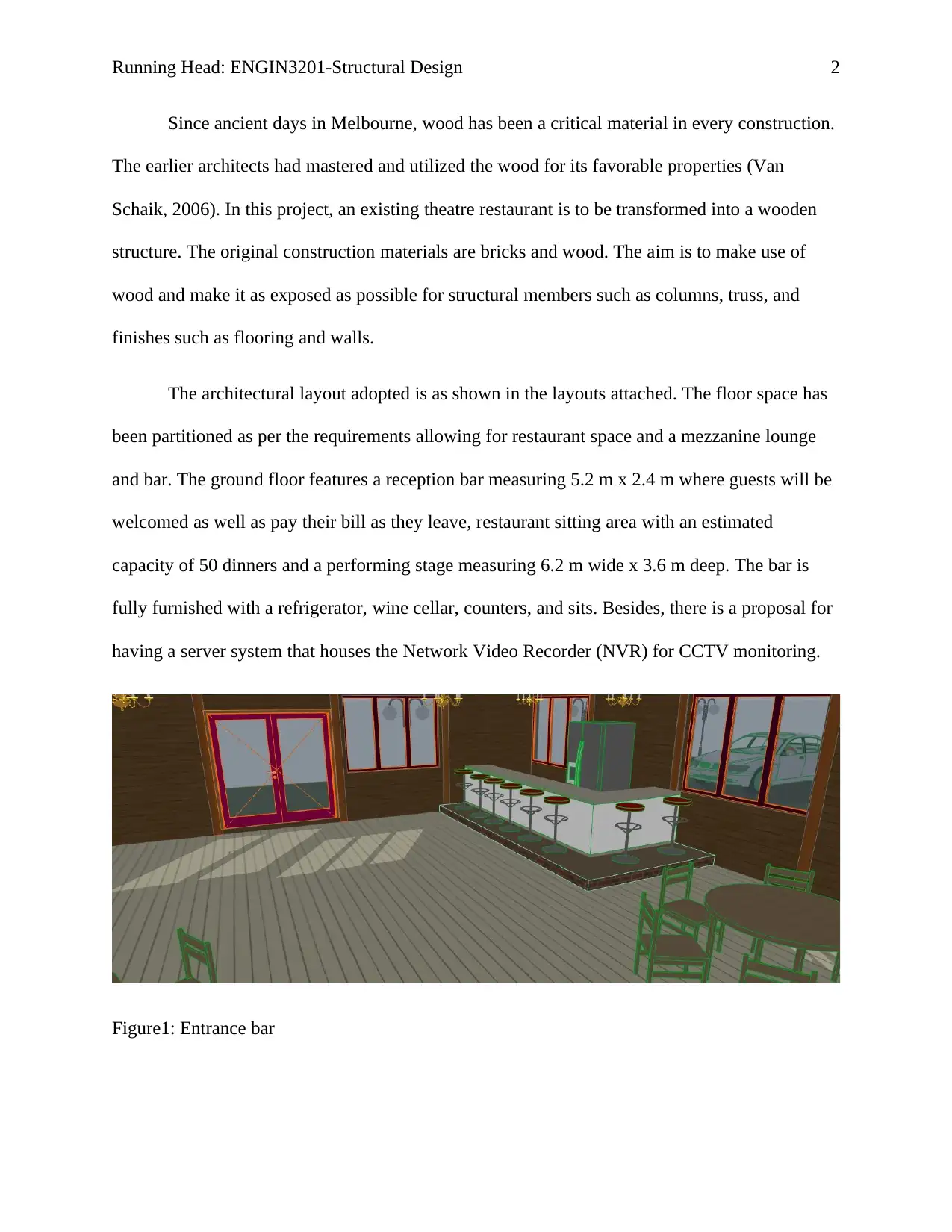
Running Head: ENGIN3201-Structural Design 2
Since ancient days in Melbourne, wood has been a critical material in every construction.
The earlier architects had mastered and utilized the wood for its favorable properties (Van
Schaik, 2006). In this project, an existing theatre restaurant is to be transformed into a wooden
structure. The original construction materials are bricks and wood. The aim is to make use of
wood and make it as exposed as possible for structural members such as columns, truss, and
finishes such as flooring and walls.
The architectural layout adopted is as shown in the layouts attached. The floor space has
been partitioned as per the requirements allowing for restaurant space and a mezzanine lounge
and bar. The ground floor features a reception bar measuring 5.2 m x 2.4 m where guests will be
welcomed as well as pay their bill as they leave, restaurant sitting area with an estimated
capacity of 50 dinners and a performing stage measuring 6.2 m wide x 3.6 m deep. The bar is
fully furnished with a refrigerator, wine cellar, counters, and sits. Besides, there is a proposal for
having a server system that houses the Network Video Recorder (NVR) for CCTV monitoring.
Figure1: Entrance bar
Since ancient days in Melbourne, wood has been a critical material in every construction.
The earlier architects had mastered and utilized the wood for its favorable properties (Van
Schaik, 2006). In this project, an existing theatre restaurant is to be transformed into a wooden
structure. The original construction materials are bricks and wood. The aim is to make use of
wood and make it as exposed as possible for structural members such as columns, truss, and
finishes such as flooring and walls.
The architectural layout adopted is as shown in the layouts attached. The floor space has
been partitioned as per the requirements allowing for restaurant space and a mezzanine lounge
and bar. The ground floor features a reception bar measuring 5.2 m x 2.4 m where guests will be
welcomed as well as pay their bill as they leave, restaurant sitting area with an estimated
capacity of 50 dinners and a performing stage measuring 6.2 m wide x 3.6 m deep. The bar is
fully furnished with a refrigerator, wine cellar, counters, and sits. Besides, there is a proposal for
having a server system that houses the Network Video Recorder (NVR) for CCTV monitoring.
Figure1: Entrance bar
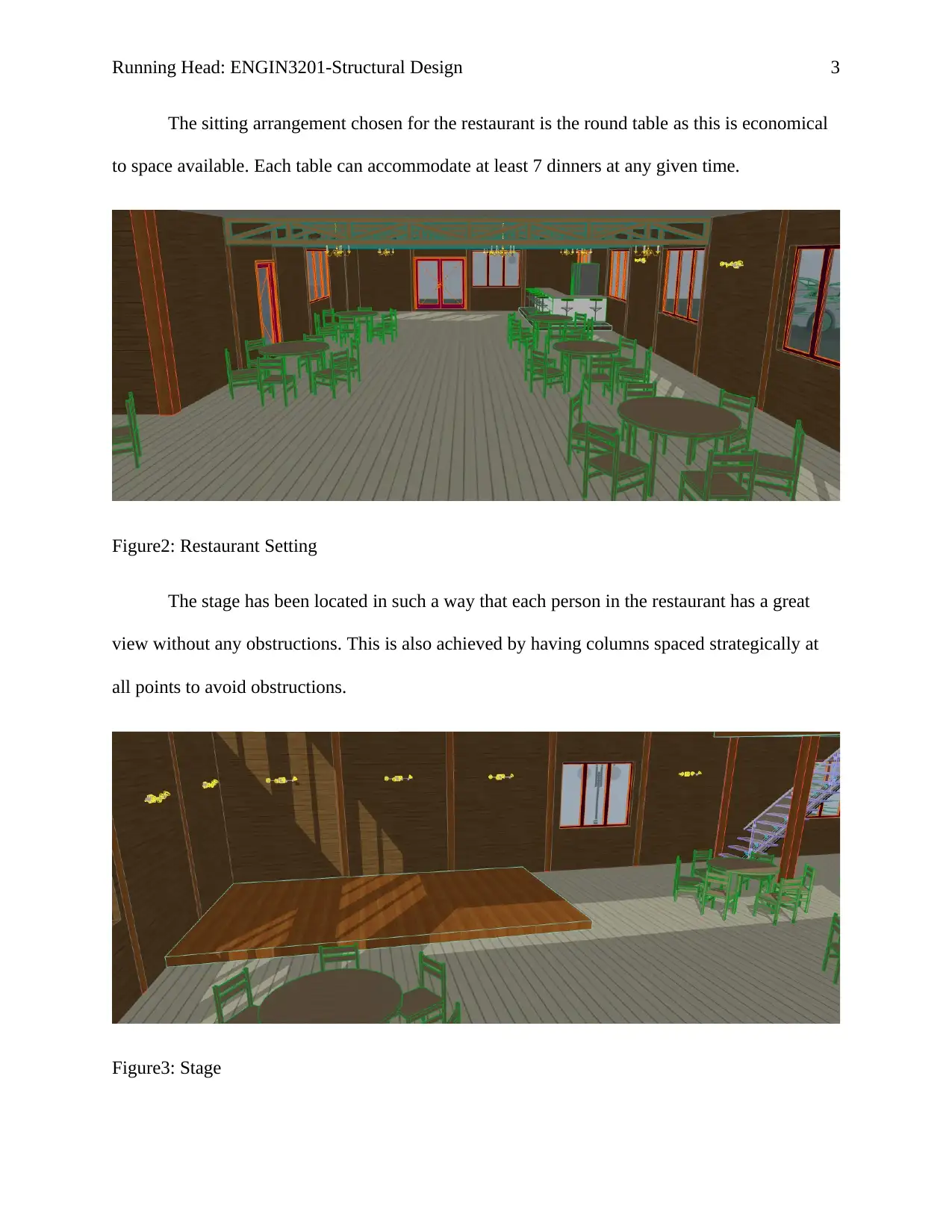
Running Head: ENGIN3201-Structural Design 3
The sitting arrangement chosen for the restaurant is the round table as this is economical
to space available. Each table can accommodate at least 7 dinners at any given time.
Figure2: Restaurant Setting
The stage has been located in such a way that each person in the restaurant has a great
view without any obstructions. This is also achieved by having columns spaced strategically at
all points to avoid obstructions.
Figure3: Stage
The sitting arrangement chosen for the restaurant is the round table as this is economical
to space available. Each table can accommodate at least 7 dinners at any given time.
Figure2: Restaurant Setting
The stage has been located in such a way that each person in the restaurant has a great
view without any obstructions. This is also achieved by having columns spaced strategically at
all points to avoid obstructions.
Figure3: Stage
⊘ This is a preview!⊘
Do you want full access?
Subscribe today to unlock all pages.

Trusted by 1+ million students worldwide

Running Head: ENGIN3201-Structural Design 4
Also, on the ground floor, there is a fully furnished kitchen, changing rooms for male and
female actors as well as a storage room. The rooms have been partitioned in such a way that
there is privacy for the restaurant staff. The toilets for the restaurant shall be on a separate
building to a later detail.
The interior lighting in the restaurant is provided by chandeliers suspended from the truss
as well as wall-mounted spotlights to enhance the lighting. The restaurant varies in height with
the area housing the stage having a higher headroom while the other section having a lower
headroom. The truss chosen for the restaurant is a flat wooden truss. This is important as it acts
as a castellated beam allowing for spaces for services such as electrical conduits and ducts for air
conditioning to pass through without compromising the headroom (Elaiwi, Kim, and Li, 2018).
The restaurant roof is a slanting type and made of vinyl membrane tiles. The slope is 10 degrees
hence efficient to accommodate air conditioning and ventilation equipment if need be.
A wooden staircase leads to the mezzanine lounge which features a bar as well. The
staircase has been designed as per the AS1170.1 such that the risers are limited to 18. Riser and
Going dimensions have been taken from Table D2.13 below (Turner, 2010). The stringer and
treads are made from F17 seasoned messmate wood with the loading of 3KN/m2.
Also, on the ground floor, there is a fully furnished kitchen, changing rooms for male and
female actors as well as a storage room. The rooms have been partitioned in such a way that
there is privacy for the restaurant staff. The toilets for the restaurant shall be on a separate
building to a later detail.
The interior lighting in the restaurant is provided by chandeliers suspended from the truss
as well as wall-mounted spotlights to enhance the lighting. The restaurant varies in height with
the area housing the stage having a higher headroom while the other section having a lower
headroom. The truss chosen for the restaurant is a flat wooden truss. This is important as it acts
as a castellated beam allowing for spaces for services such as electrical conduits and ducts for air
conditioning to pass through without compromising the headroom (Elaiwi, Kim, and Li, 2018).
The restaurant roof is a slanting type and made of vinyl membrane tiles. The slope is 10 degrees
hence efficient to accommodate air conditioning and ventilation equipment if need be.
A wooden staircase leads to the mezzanine lounge which features a bar as well. The
staircase has been designed as per the AS1170.1 such that the risers are limited to 18. Riser and
Going dimensions have been taken from Table D2.13 below (Turner, 2010). The stringer and
treads are made from F17 seasoned messmate wood with the loading of 3KN/m2.
Paraphrase This Document
Need a fresh take? Get an instant paraphrase of this document with our AI Paraphraser
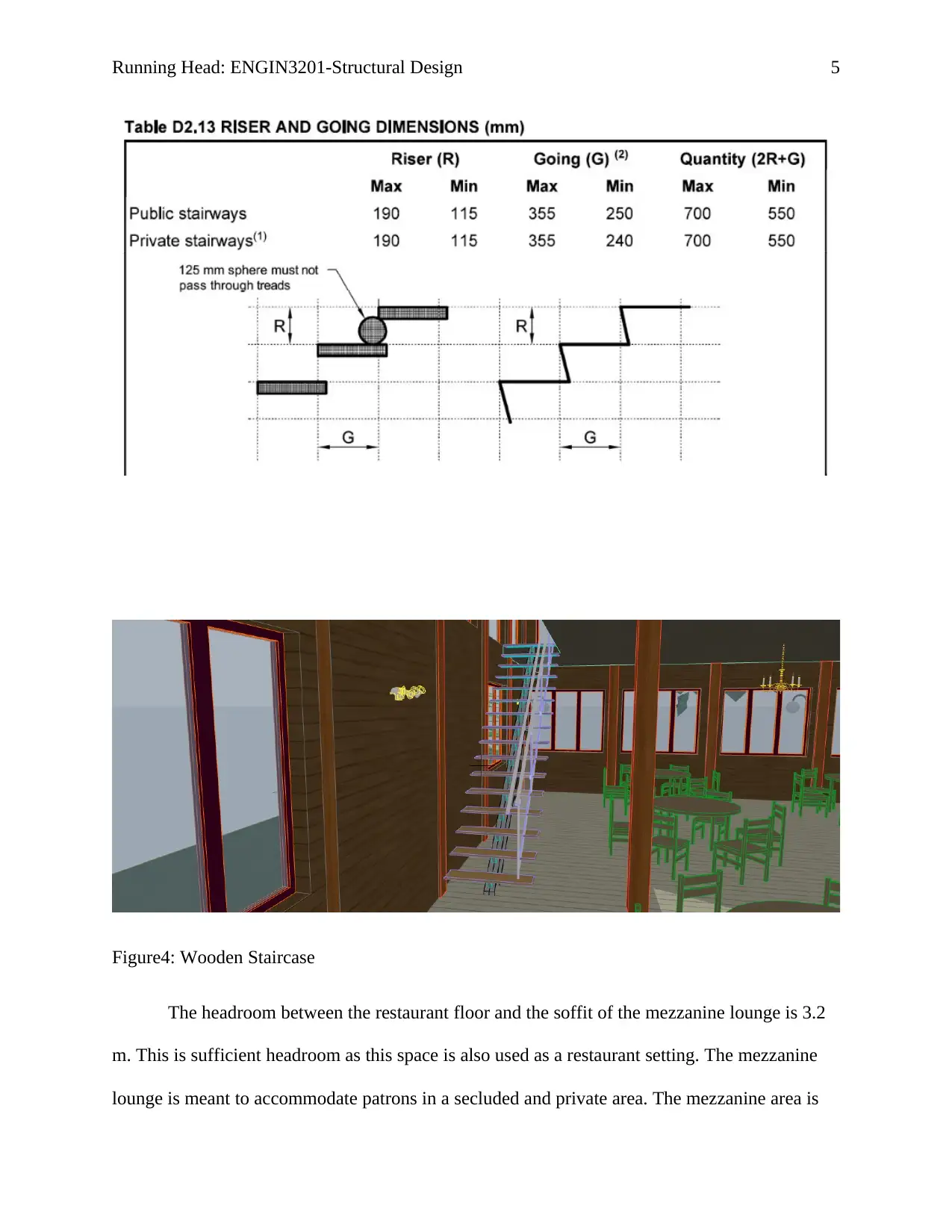
Running Head: ENGIN3201-Structural Design 5
Figure4: Wooden Staircase
The headroom between the restaurant floor and the soffit of the mezzanine lounge is 3.2
m. This is sufficient headroom as this space is also used as a restaurant setting. The mezzanine
lounge is meant to accommodate patrons in a secluded and private area. The mezzanine area is
Figure4: Wooden Staircase
The headroom between the restaurant floor and the soffit of the mezzanine lounge is 3.2
m. This is sufficient headroom as this space is also used as a restaurant setting. The mezzanine
lounge is meant to accommodate patrons in a secluded and private area. The mezzanine area is
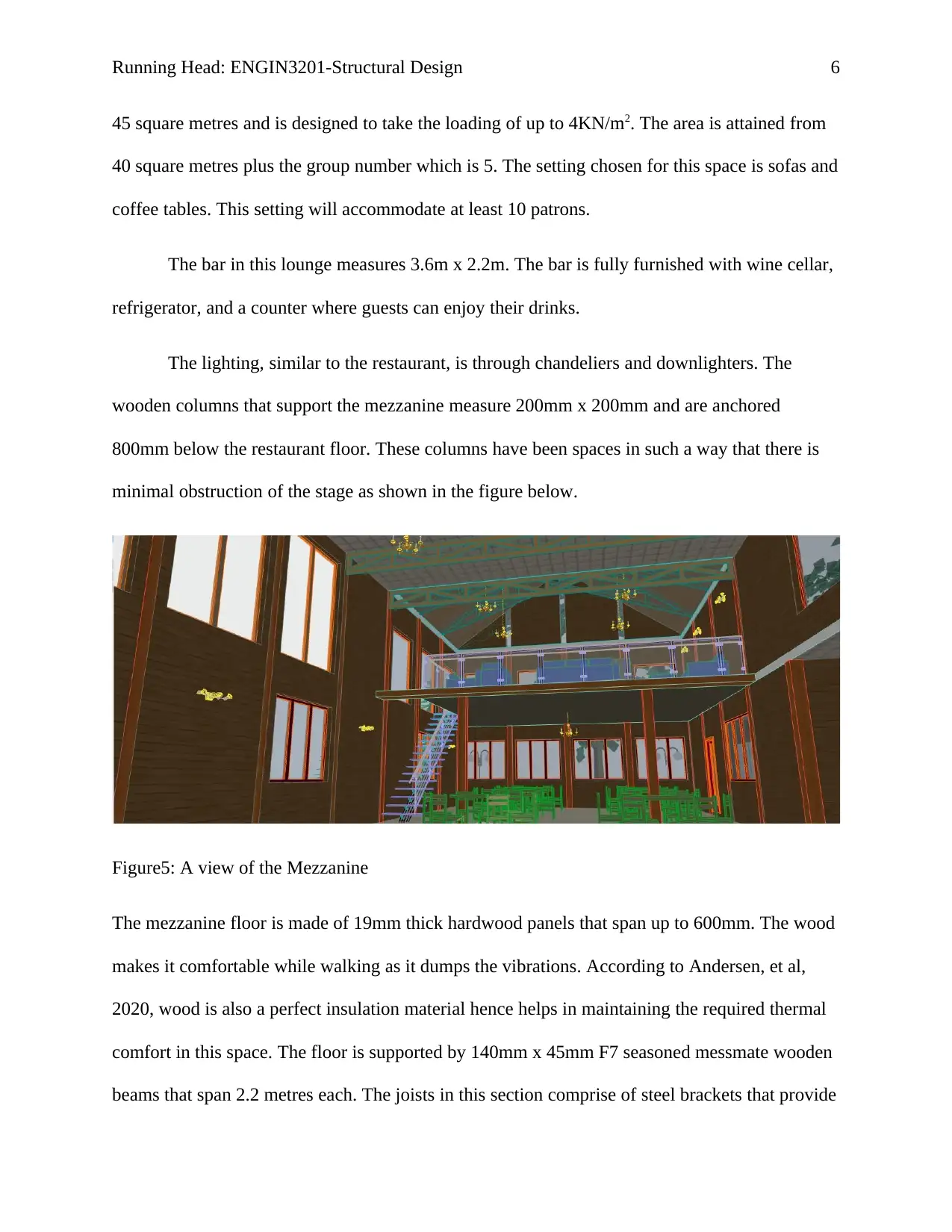
Running Head: ENGIN3201-Structural Design 6
45 square metres and is designed to take the loading of up to 4KN/m2. The area is attained from
40 square metres plus the group number which is 5. The setting chosen for this space is sofas and
coffee tables. This setting will accommodate at least 10 patrons.
The bar in this lounge measures 3.6m x 2.2m. The bar is fully furnished with wine cellar,
refrigerator, and a counter where guests can enjoy their drinks.
The lighting, similar to the restaurant, is through chandeliers and downlighters. The
wooden columns that support the mezzanine measure 200mm x 200mm and are anchored
800mm below the restaurant floor. These columns have been spaces in such a way that there is
minimal obstruction of the stage as shown in the figure below.
Figure5: A view of the Mezzanine
The mezzanine floor is made of 19mm thick hardwood panels that span up to 600mm. The wood
makes it comfortable while walking as it dumps the vibrations. According to Andersen, et al,
2020, wood is also a perfect insulation material hence helps in maintaining the required thermal
comfort in this space. The floor is supported by 140mm x 45mm F7 seasoned messmate wooden
beams that span 2.2 metres each. The joists in this section comprise of steel brackets that provide
45 square metres and is designed to take the loading of up to 4KN/m2. The area is attained from
40 square metres plus the group number which is 5. The setting chosen for this space is sofas and
coffee tables. This setting will accommodate at least 10 patrons.
The bar in this lounge measures 3.6m x 2.2m. The bar is fully furnished with wine cellar,
refrigerator, and a counter where guests can enjoy their drinks.
The lighting, similar to the restaurant, is through chandeliers and downlighters. The
wooden columns that support the mezzanine measure 200mm x 200mm and are anchored
800mm below the restaurant floor. These columns have been spaces in such a way that there is
minimal obstruction of the stage as shown in the figure below.
Figure5: A view of the Mezzanine
The mezzanine floor is made of 19mm thick hardwood panels that span up to 600mm. The wood
makes it comfortable while walking as it dumps the vibrations. According to Andersen, et al,
2020, wood is also a perfect insulation material hence helps in maintaining the required thermal
comfort in this space. The floor is supported by 140mm x 45mm F7 seasoned messmate wooden
beams that span 2.2 metres each. The joists in this section comprise of steel brackets that provide
⊘ This is a preview!⊘
Do you want full access?
Subscribe today to unlock all pages.

Trusted by 1+ million students worldwide
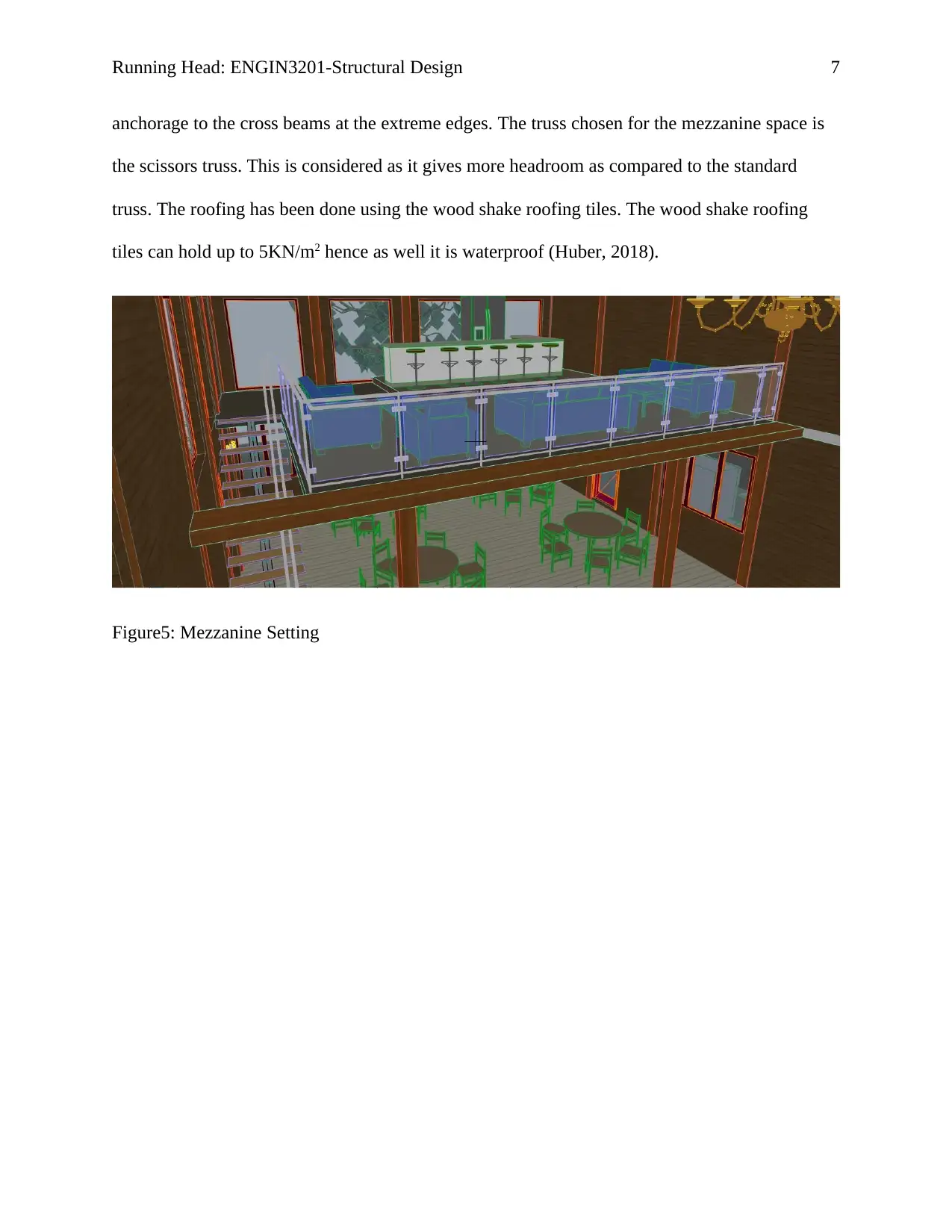
Running Head: ENGIN3201-Structural Design 7
anchorage to the cross beams at the extreme edges. The truss chosen for the mezzanine space is
the scissors truss. This is considered as it gives more headroom as compared to the standard
truss. The roofing has been done using the wood shake roofing tiles. The wood shake roofing
tiles can hold up to 5KN/m2 hence as well it is waterproof (Huber, 2018).
Figure5: Mezzanine Setting
anchorage to the cross beams at the extreme edges. The truss chosen for the mezzanine space is
the scissors truss. This is considered as it gives more headroom as compared to the standard
truss. The roofing has been done using the wood shake roofing tiles. The wood shake roofing
tiles can hold up to 5KN/m2 hence as well it is waterproof (Huber, 2018).
Figure5: Mezzanine Setting
Paraphrase This Document
Need a fresh take? Get an instant paraphrase of this document with our AI Paraphraser
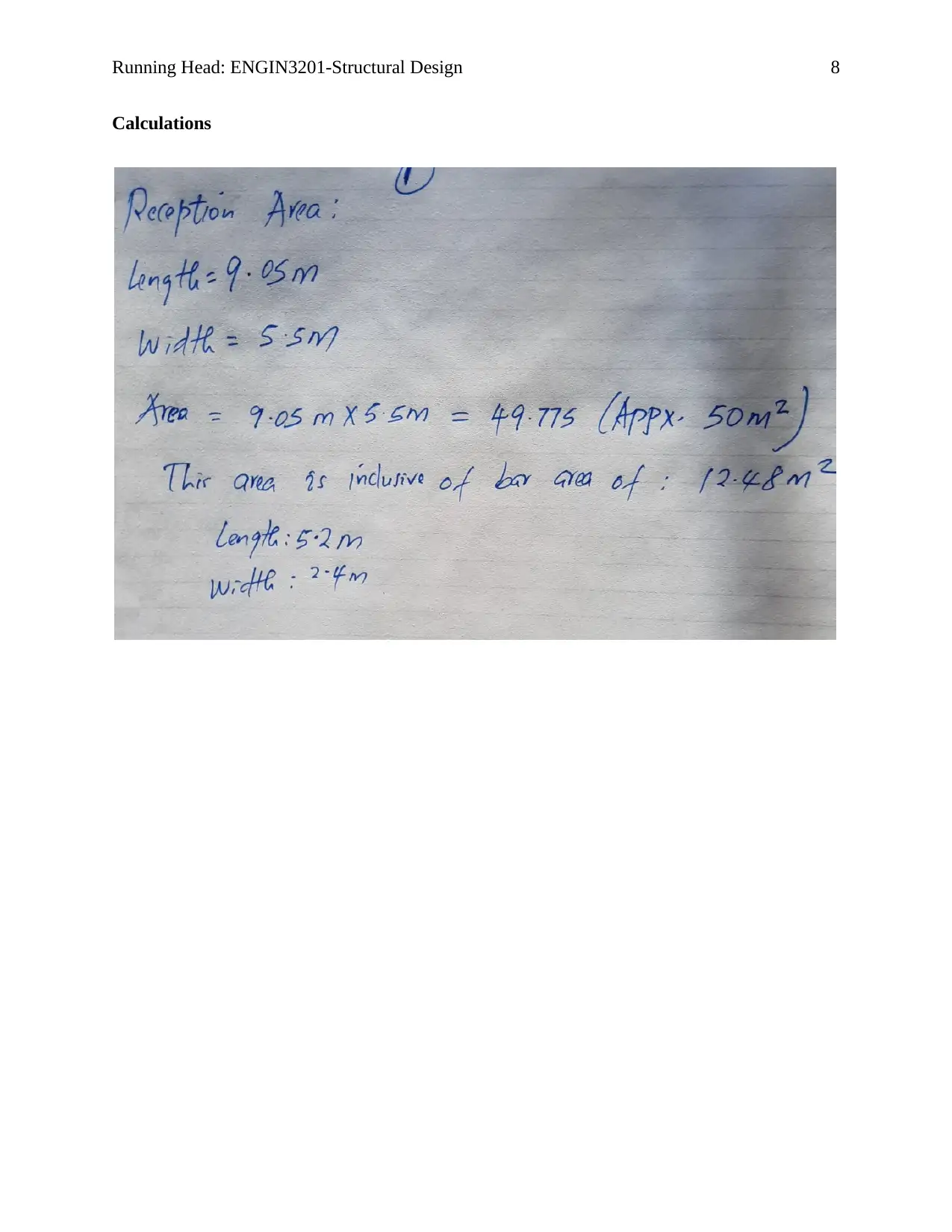
Running Head: ENGIN3201-Structural Design 8
Calculations
Calculations
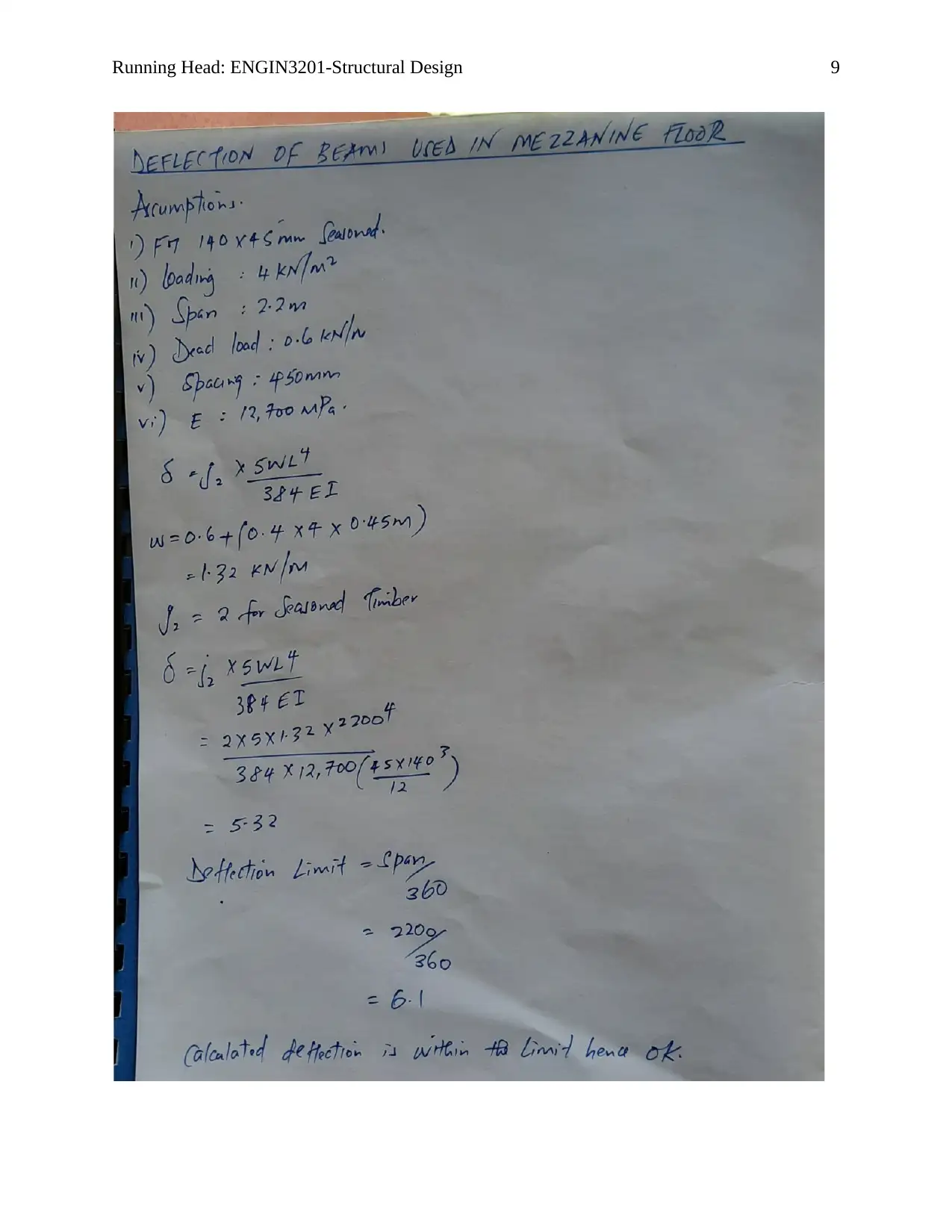
Running Head: ENGIN3201-Structural Design 9
⊘ This is a preview!⊘
Do you want full access?
Subscribe today to unlock all pages.

Trusted by 1+ million students worldwide
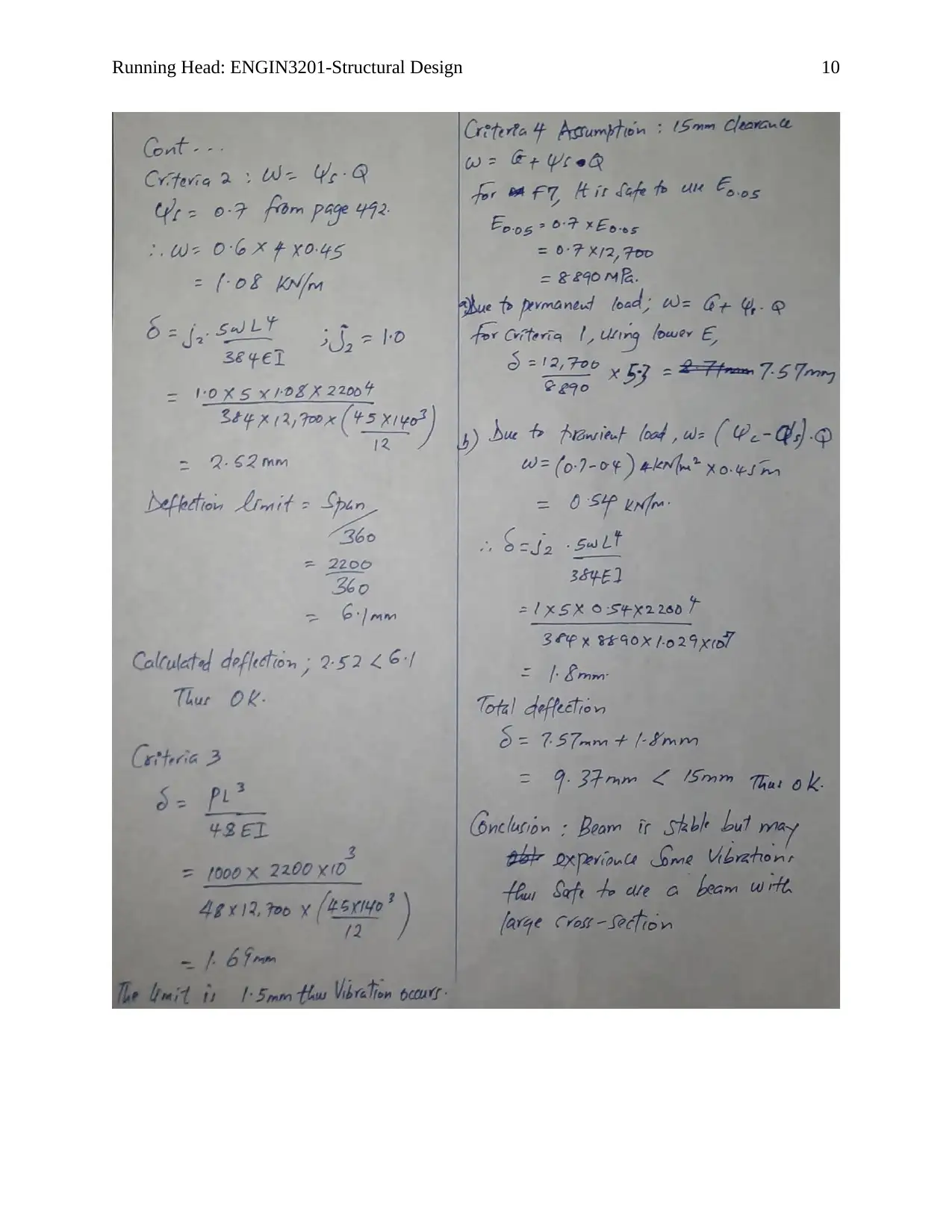
Running Head: ENGIN3201-Structural Design 10
Paraphrase This Document
Need a fresh take? Get an instant paraphrase of this document with our AI Paraphraser

Running Head: ENGIN3201-Structural Design 11
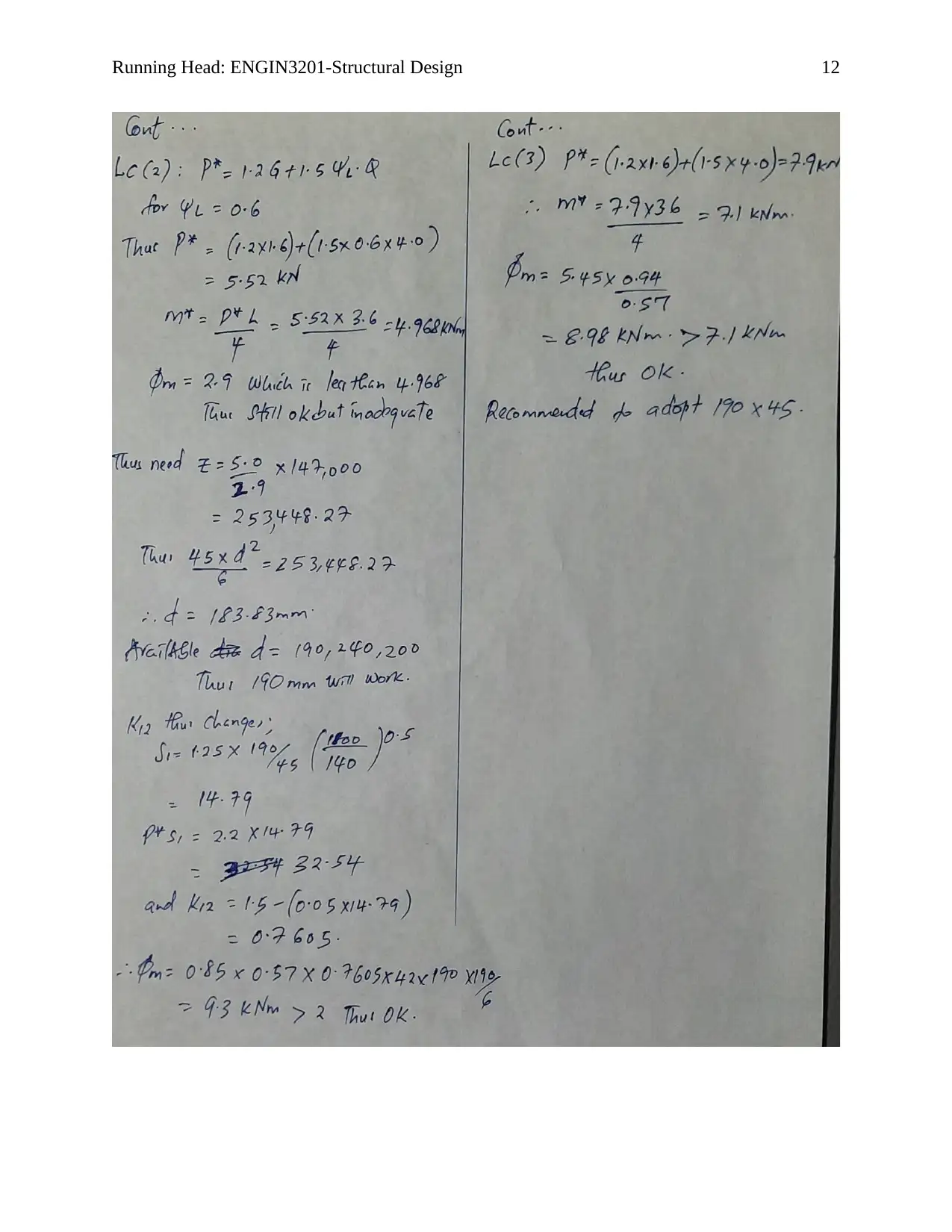
Running Head: ENGIN3201-Structural Design 12
⊘ This is a preview!⊘
Do you want full access?
Subscribe today to unlock all pages.

Trusted by 1+ million students worldwide
1 out of 15
Your All-in-One AI-Powered Toolkit for Academic Success.
+13062052269
info@desklib.com
Available 24*7 on WhatsApp / Email
![[object Object]](/_next/static/media/star-bottom.7253800d.svg)
Unlock your academic potential
Copyright © 2020–2025 A2Z Services. All Rights Reserved. Developed and managed by ZUCOL.